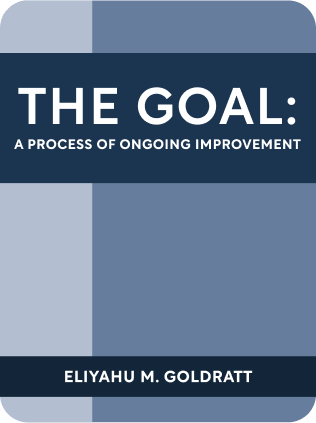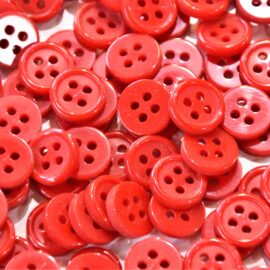

This article is an excerpt from the Shortform book guide to "The Goal: A Process of Ongoing Improvement" by Eliyahu M. Goldratt. Shortform has the world's best summaries and analyses of books you should be reading.
Like this article? Sign up for a free trial here .
What is the drum-buffer-rope method? How does The Goal apply this method to improve production and output?
The drum-buffer-rope method is a strategy The Goal suggests to optimize production. You address bottlenecks and then synchronize bottlenecks and non-bottlenecks.
Keep reading for more about the drum-buffer-rope method and why it works.
The Need for the Drum-Buffer-Rope Method
In the story, the team identifies a robot as the bottleneck. They devise a system whereby all parts destined for the bottleneck are always worked on at highest priority at non-bottleneck steps. This increases throughput temporarily, until they discover that at final assembly, suddenly there are shortages in non-bottleneck parts while there is massive inventory upstream of the bottleneck. How could this be?
They discover that they were running non-bottlenecks at full-speed and cranking out bottleneck parts far in excess of what the bottleneck could process. In turn, the non-bottlenecks had insufficient capacity to produce their non-bottleneck parts.
To avoid this, you must synchronize the non-bottlenecks with the bottleneck, to prevent massive deviations. Goldratt proposed the Drum-Buffer-Rope method, as follows:
Drum
The bottleneck dictates the pace of production of non-bottlenecks.
Analogy: the slow boy scout beats a drum, and others take steps with the drum beat. If the boy scout beats more slowly, everyone else steps more slowly.
Similarly, a machine may regularly report its production rate, and the non-bottlenecks adjust their own rates up and down accordingly.
Release starting materials to the non-bottlenecks strictly at the drumbeat rate.
- The lead time can be calculated so the starting resources pass through upstream steps and arrive just in time at the bottleneck.
- Similarly, all independent non-bottleneck routes can be timed so that all parts meet at assembly simultaneously.
Buffer
The bottleneck should have surplus inventory upstream so it doesn’t idle.
Analogy: non-bottleneck boys can scout ahead, clear brush so the bottleneck boy can keep walking at normal pace without having to stop.
This buffer allows for “good enough” scheduling rather than needing to be perfectly accurate.
Goldratt suggests choosing a time buffer equal to half the current lead time, then decreasing or increasing as deadlines or hit or missed.
Rope
When non-bottlenecks exceed a certain surplus level, they idle.
Analogy: tie a rope between the boy in the front and the bottleneck boy, and limit the maximum distance between the two.
Similarly, prevent work-in-process inventory from exceeding a threshold level.
- Henry Ford purposely limited space for inventory to detect bottlenecks.
- In Toyota manufacturing, inventory is limited to containers containing a number of units, marked by a card. When this container is withdrawn for further processing, the card is returned to the upstream work center – only then can the center produce.
- In Kanban software engineering, no work can be added to a pipeline until the existing work has been moved to the next pipeline.
In addition, production requires prioritization – complicated chains require more parts to be worked on in the correct order to avoid queue times. As a simple heuristic, prioritize batches by time elapsed since its release – the longer parts have been waiting, the higher the priority they get worked on.
Benefits of the Drum-Buffer-Rope Method
By adopting lean manufacturing principles like bottleneck alleviation, small batches, and Drum-Buffer-Rope systems, a cascading series of benefits happens:
- You improve throughput, lower inventory costs, and limit traffic jams.
- This decreases turnaround times.
- This in turn reduces cost per product (by spreading fixed costs over more products).
- Which allows lower prices and increases sales.
- You can also respond faster to the market.
Misleading Accounting Disguises Progress
Measurements like financial accounting should induce the organization to do what’s good for itself. But as you improve throughput, traditional accounting measures may make your situation look worse than it really is.
Examples:
- Inventory is usually marked as assets, and reducing inventory will show up as a loss in assets.
- Drum-buffer-rope will cause idle time at non-bottlenecks, thus decreasing local efficiencies.
- Consuming surplus inventory (beyond that determined by drum-buffer-rope) will decrease local efficiencies.
- Decreasing batch sizes increases setup time and overhead, thus increasing apparent cost-per-part.

———End of Preview———
Like what you just read? Read the rest of the world's best book summary and analysis of Eliyahu M. Goldratt's "The Goal: A Process of Ongoing Improvement" at Shortform .
Here's what you'll find in our full The Goal: A Process of Ongoing Improvement summary :
- How to increase your personal output
- How to increase your team's output
- Why obsessing over cost efficiency isn't going to help you with production






